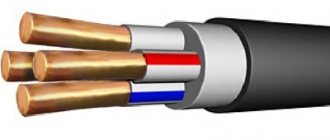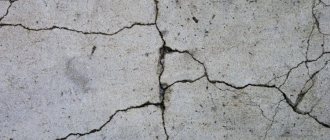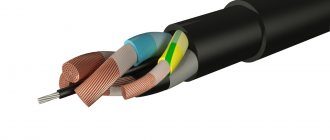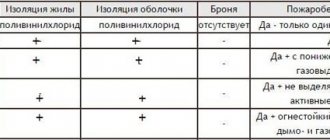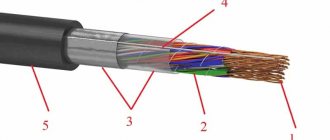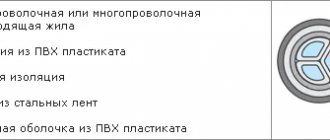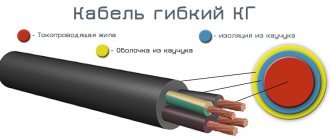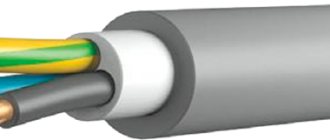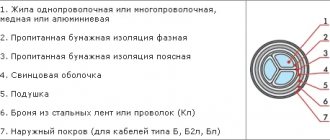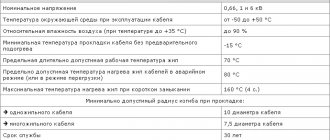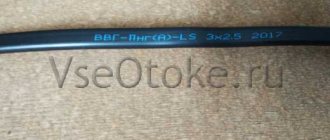This type of cable, VbbShV, is a highly reliable armored wire equipped with copper conductors and a polyvinyl chloride hose. Due to the presence of steel armor on it, such a cable can be used for installation and use even in the most severe conditions, since it is reliably protected from all types of mechanical damage, with the exception of stretching.
What the design of the VbbShV cable is and what its technical characteristics and scope of application are, we will tell you in this material.
Marking features
Any power cable is a macro structure consisting of the following main components:
- Conductive conductor. This is a copper or aluminum wire with a round or sector cross-section. At the same time, they do not necessarily have to be solid - stacked cores from a large number of small-section wires are often used. This approach makes it possible to reduce the resulting Foucault surface currents, which cause local overheating of the wire. The sector version is used when there are two or more cores in the cable. It allows you to better fill the internal volume of the cable, and with the same outer diameter, obtain a larger cross-section/power compared to round conductors. Naturally this will affect your weight. This is clearly demonstrated in the following illustration:
- Core insulation Polymer material that prevents direct contact of the cores with each other and with the outside space,
- Additional shell. A layer of polymer or metallized material covering insulated conductors and performing specific functions,
- Outer shell. This is the outer layer of the cable, used to protect the internal components and keep them compact. Depending on the material, the requirements of the manufacturer and the consumer, it is also capable of performing various additional functions.
The marking of any power cables is based on this principle. That is, the basic designation should consist of three to four groups of symbols, and all the rest will indicate additional properties or functions. Let's consider this scheme using the example of the brands of cable products mentioned above.
Explanation of the designations VBBbShv, VBBShvng, VBBShvng-FRLS and PvBbShv
So, the VBBShV cable marking consists of three groups of symbols: “V” - “BB” - “Shv”. Formally, there is also a fourth, hidden symbol, which is placed in the first position and this is the symbol responsible for the material of the core. Since at first we see the letter “B” and not “A”, this automatically means that the wire is copper. Further decryption proceeds as follows:
- B – core insulation made of PVC plastic,
- BB – two-ball armor made of galvanized steel strips. It is wound in the form of a spiral with the calculation of the mutual overlap of the joints,
- Shv – the outer layer of the hose type, made of PVC.
Next comes the VBBShvng cable, which, judging by the designation, is almost an analogue of the previous one, with the exception of the last pair of characters “ng”. It means that the materials used are non-flammable, that is, if a fire occurs in the wiring, they will prevent its spread.
The VBBShvng-FRLS cable is a partial analogue of the previous one. The symbols “FR” and “LS” after the dash mean high fire resistance and low smoke emission (Low Smoke). A fire on such wiring not only spreads poorly, but also creates optimal conditions for the evacuation of personnel due to the absence of smoke.
The last is the cable under the brand PvBbShV, which is an analogue of VBBShV, with the only exception that the basic core insulation is made of vulcanized polyethylene (“Pv”).
Scope of application of VBShv cable
The VBShv cable is intended for use in stationary closed electrical installations.
The cable is used for distribution and transmission of electricity to end consumers by laying through earthen trenches, cable channels, sewers, open air spaces and premises at power receivers with voltages of 0.66, 1, 3 and 6 kV AC. They can also be used in DC networks. The cable has armor and a compacted protective sheath in the form of a hose, which allows it to be used for laying in pre-prepared trenches. When laying through open air areas, UV protection such as cable ducts, trays and corrugated pipes is required, as direct sunlight will reduce the life of the sheathing and insulation materials. The VBShv cable is produced in various modifications, differing in operating conditions, as well as fire safety requirements.
The VBShv cable is protected from both mechanical and chemical influences. The cables can withstand high levels of corrosion load. The cables are armored with galvanized steel tape, which allows the cables to be installed underground, as well as in rooms with a risk of mechanical shock damage. At the same time, it is necessary to observe measures to protect against tensile influences.
In order to protect against tension, in environments that pose a risk of tensile effects (for example, underground), the “snake” laying technique is used, in which the cable is pulled loosely, leaving a reserve of tension based on the flowability of the soil and the cushion. Also, you should avoid hanging the cable in the open air without using supporting cables and fastening elements. When installing trench cable lines, it is necessary to exclude cable intersections with other communication systems and tree roots. If it is impossible to eliminate intersections, the use of cable trays and canisters is required in sections of the cable route.
The cables are considered fireproof. The polyvinyl chloride polymer that makes up the insulation and shell is resistant to sudden overheating and heating during short circuits, up to 160°C. Also, cables are allowed to be used in an environment of partial and complete flooding of cables, provided that the joints are absent/sealed. This modification does not propagate combustion when laid alone. In the case of group laying, it is necessary to use additional fire protection means (fireproof cushions, mastics, varnishes). Also, for laying in bundles, a modification with the index “ng” is used, which does not spread fire when laid in group bundles. Laying in conditions of high explosion and fire hazard is permissible, but it should be taken into account that the basic modification is not resistant to open fire. In conditions of high risk of fires and to provide power to fire systems, a modification with the index “ng(A)-FR” is used, which has additional protection of current-carrying conductors made of mica-containing tapes that are resistant to open fire.
Properties of VBBShV cable
According to Gosstandart, this type of conductor is used for direct transmission and distribution of electricity at an industrial frequency of 50 Hz with an alternating voltage of 660 or 1000 V. The number of cores can vary from 1 to 5. Their cross-section ranges from 1.5 to 240 mm2. The linear weight of 1 km of VBBShV cable ranges from 347 to 11305 kg. During installation, it is necessary to take into account the minimum bending radii, which are equal to 10 outer diameters for a single-core version and 7.5 diameters for a multi-core version. Marking of cores occurs through colored insulation or digital application (for cross-sections over 70 mm2).
Due to the implemented design solutions, VBBShV cables can be used in various climatic, temperature and technical conditions.
Specifications
- The operating frequency is 50 Hertz;
- alternating voltage 6 kV;
- DC voltage is 2.4 times higher than AC voltage. Here you will have to count on your own;
- heating of the cores in emergency mode should not exceed +80 degrees;
- Duration of operation in emergency mode is no more than 8 hours per day. During the entire period of operation, work in emergency mode should not exceed 1000 hours;
- the conductors are made of copper. Section from 16 to 240 mm. It depends on the number of cores;
- The cable is armored.
Cable type VBBShvng-FRLS
If you analyze the designation, there is an obvious analogy with the previous type. The symbols used after the dash indicate that the polymer cable sheaths have excellent fire resistance and low gas emissions during combustion. Literally, this means that in the event of a fire on the line, there will be no smoke.
This combination of properties makes it possible to use VBBShvng-FRLS in the most difficult conditions, in rooms with a high level of fire hazard, in places where there is a threat of mechanical impact on the cable, etc. The minimum value of the bending radius during installation is calculated with a multiplicity factor of 7.5 in relation to the outer diameter.
Storage and transportation rules
The cable should only be stored in a dry and ventilated place. There should be no rodents or fungus in the room. Temporary storage of products in cable drums in the open air is permitted. During transportation, do not twist, bend or place the cable in a tight box, this can lead to mechanical damage and failure. The product should be kept away from sharp objects, as the PVC shell can easily be damaged.
During loading or unloading, as well as laying, safety precautions must be observed. You cannot try to carry the cable alone, as it is quite heavy. When laying by air, you need to prepare supports that will protect the product from sagging.
Storing products in a warehouse
In warehouses and stores, cables are stored in their original packaging. If its integrity is compromised, its service life is reduced.
In conclusion, it should be noted that cable laying work must be trusted to professional craftsmen. It is advisable to buy products only from trusted suppliers with a guarantee of at least 3 years.
PvBBShv or polyethylene versus PVC
The PvBBShV cable, in which the basic core insulation is made of vulcanized polyethylene material, deserves special attention in this list. Like other predecessors, it can be single- or multi-core (from 2 to 4). The cross-section of an individual PvBbShV core can vary in the range from 4 to 240 mm2. The weight of a linear meter of cable varies from 0.44 to 8.69 kg for sizes 2x6 and 4x240. In this case, the maximum outer diameter is 54.2 mm.
PvBBShV can be used in rather difficult climatic conditions, in rooms with different levels of corrosive activity of the environment, and the possibility of mechanical damage. This automatically means that the manufacturer of PvBbShV provides the possibility of laying it in the ground, in specially equipped trenches.
Temperature operating conditions of PvBBShV at rated, emergency and critical (SC) currents are also not much different from previous modifications.
Power cables of the type PvBbShV or VBBShVng can be used within a fairly wide climatic and physical-technical framework, which makes them practically irreplaceable and quite universal products.
Rules for laying VBBShv
When laying the VBBShV product, you must follow certain instructions:
- the cross-section of the wire must be equal to the load on the electrical network;
- when wiring a group of wires in one trunk, they must be laid at an equal distance of at least 150 mm;
- the distance from the wire to the sewer drains must be at least 650 mm;
- the distance from the wire to the gas pipes must be at least 1000 mm;
- VBBShV type products must be laid 600 mm or more in depth from the ground level.
The VBBShV cable laying scheme is based on data on the area in which the work needs to be carried out. If the wire runs in an area far from sidewalks and asphalt, in the ground, then no preparatory measures are needed.
You might be interested in Description of speaker cable
The wire located in the trench is initially covered with sand, and then with fine soil (25 cm layer), and again with sand (about 20 cm). A warning tape is placed on the ground, a dusting is applied and the soil is compacted.
Cable storage drums
